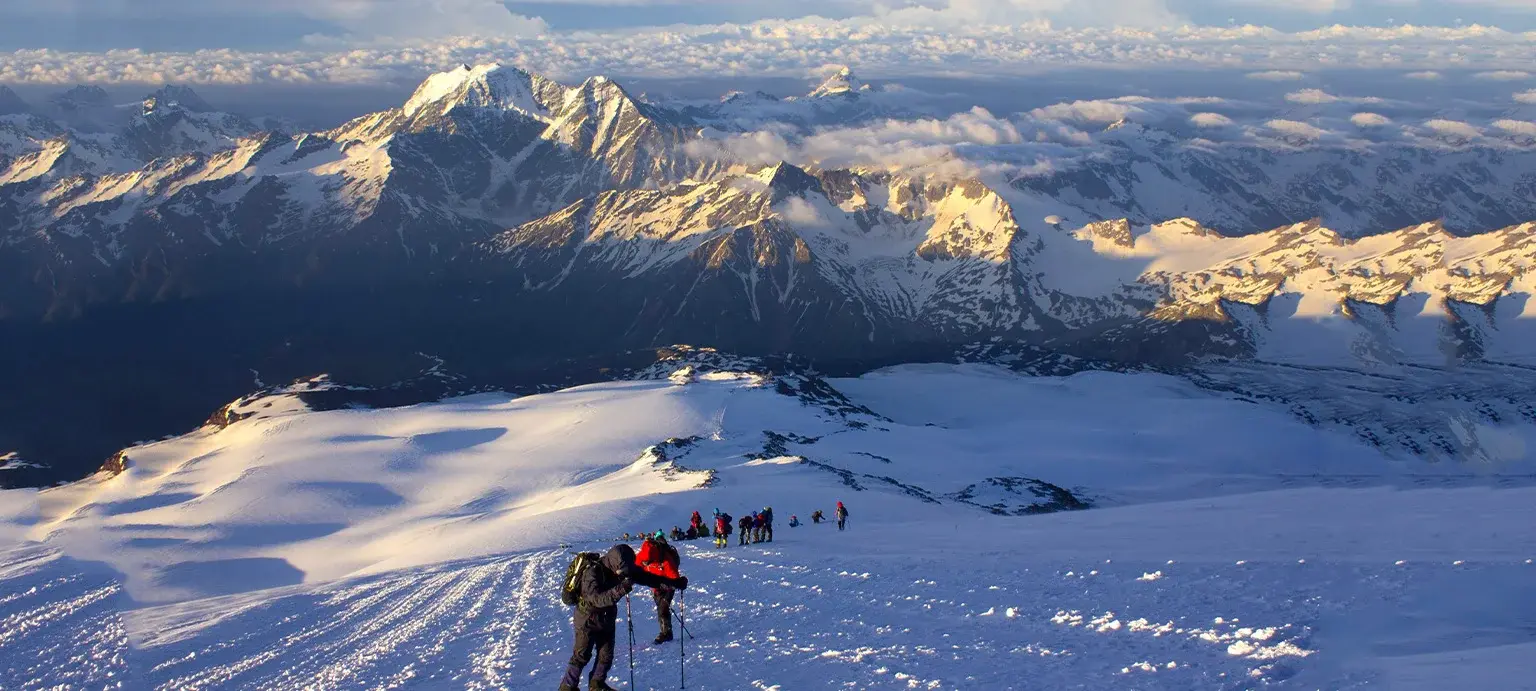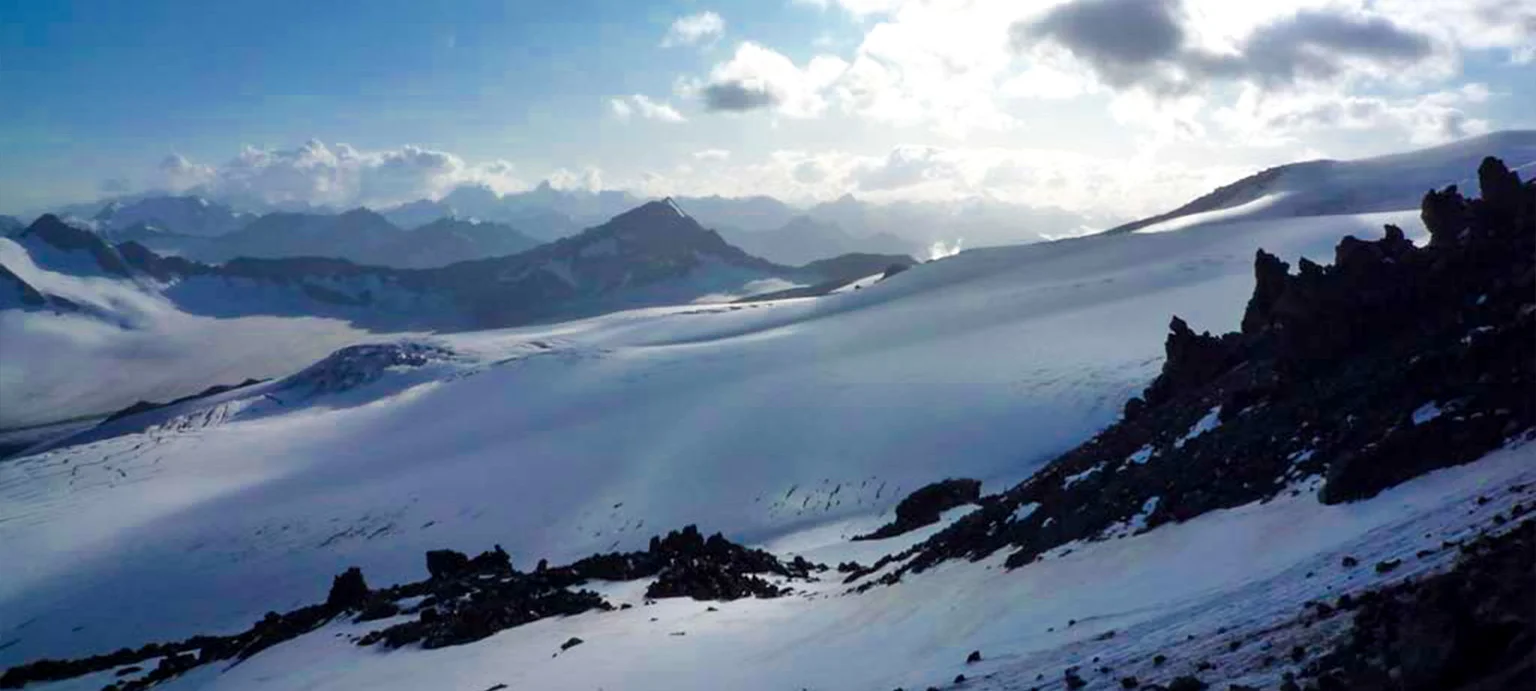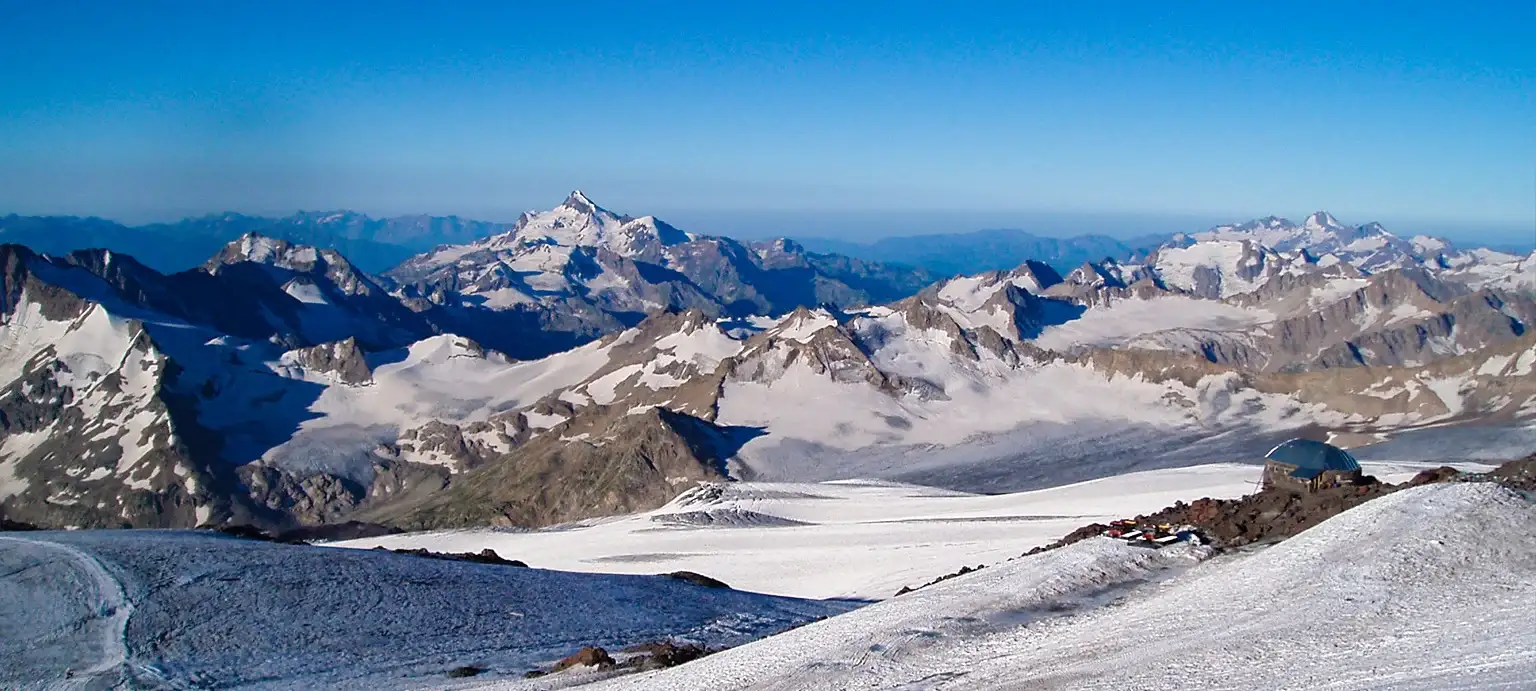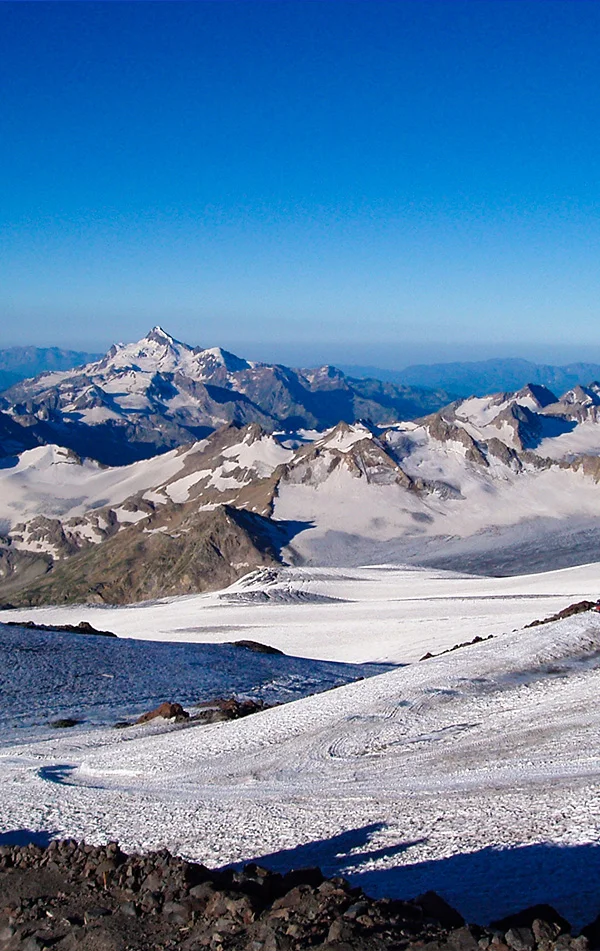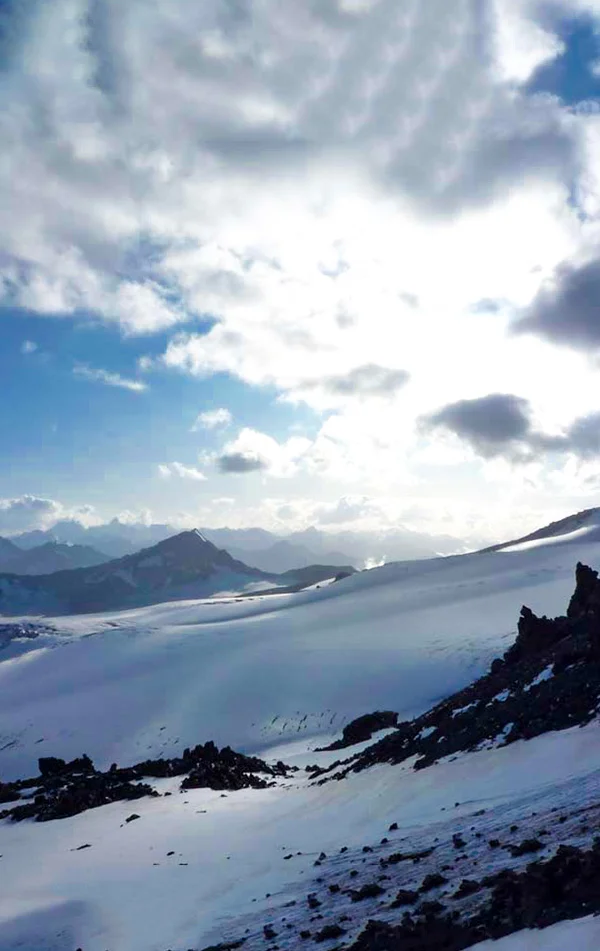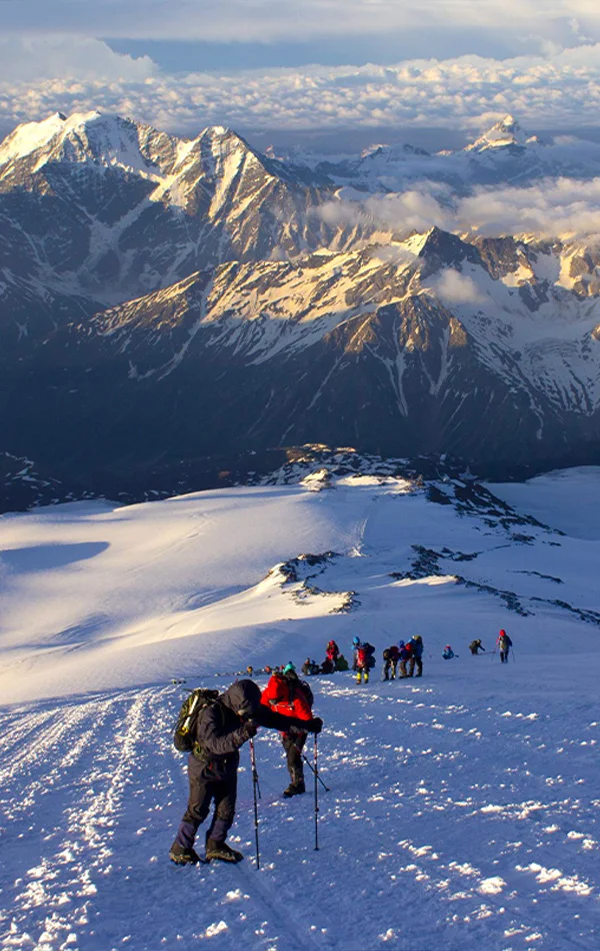Mount Elbrus Expedition

Region
Russia | Russia

Duration
8 Days

Max Altitude
18510 Ft.

Trekking Km
32 KM

Grade
Challenging
Get in Touch with Our Trek Expert
91 9690240820 info@trekthehimalayas.comMonday - Saturday: 10 AM to 06 PM (GMT +5:30)
160000 /Person
- July-2026
- August-2026
- 5% GST will be applicable on Trek Cost and Add-ons
- Services from Mineralnye Vody Airport to Mineralnye Vody Airport.
- Meeting Point( Pickup/ Drop Point ): Mineralyne Vody Airport parking Area.
- Reporting Time: 11:00 am
- Drop Time: 1:00 pm to Mineralnye Vody Airport (Timings are subject to change based on weather and road conditions).
Get in Touch with Our Trek Expert
91 9690240820info@trekthehimalayas.com
Monday - Saturday: 10 AM to 06 PM (GMT +5:30)
Overview
Trek Name: Mount Elbrus Expedition
Days: 8
Adventure Type: Mountaineering
Base Camp: Terskol
Season:Monsoon |
Month:July | August | September |
Country: Russia
Altitude: 18510 Ft.
Grade: Challenging
Rail Head: -
Stay: Hotel and Barrel Huts
Food: Veg & Non veg
Location: Russia
Distance: 32 Km.
Trail Type: Summit, Point to point | Scale a peak, Camping at the same location upon returning.
AirPort: MinVody Airport
Highlights:
- 5% GST will be applicable on Trek Cost and Add-ons
- Services from Mineralnye Vody Airport to Mineralnye Vody Airport.
- Meeting Point( Pickup/ Drop Point ): Mineralyne Vody Airport parking Area.
- Reporting Time: 11:00 am
- Drop Time: 1:00 pm to Mineralnye Vody Airport (Timings are subject to change based on weather and road conditions).
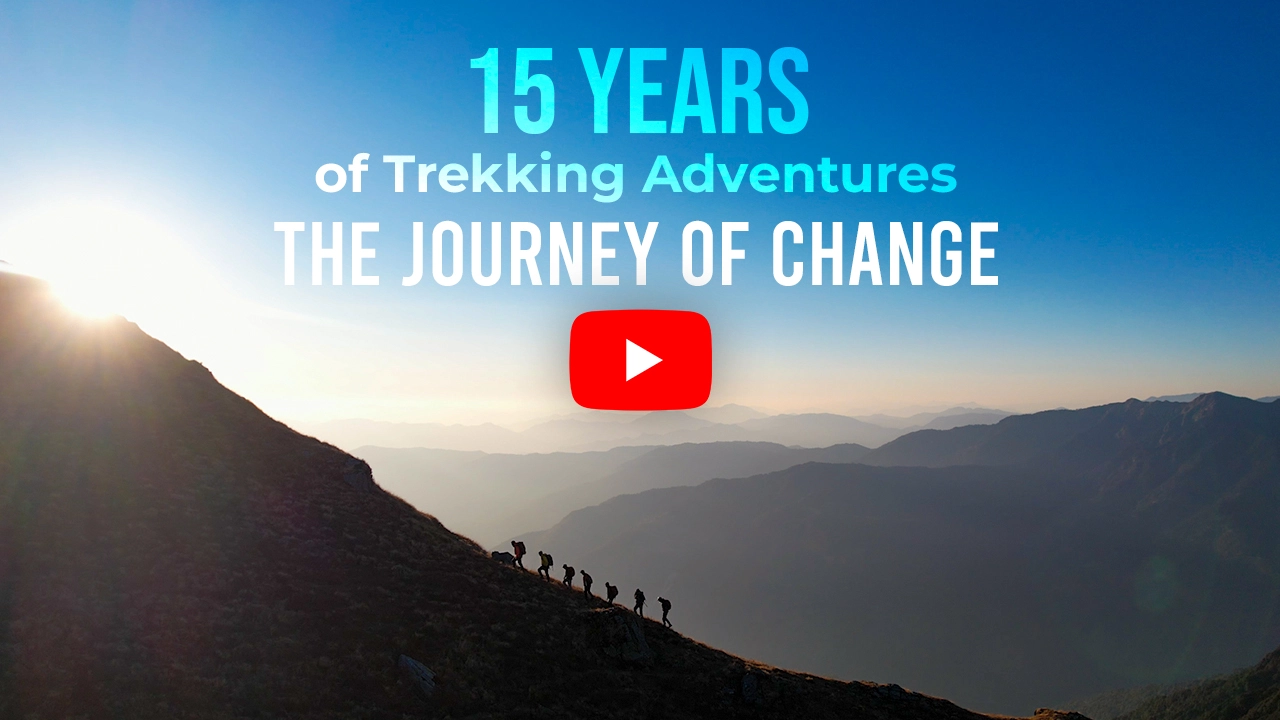
Why is Mount Elbrus a Must-Do Expedition?
- Mt. Elbrus stands at 5,642 meters (18,510 ft) and is the highest peak in Europe, making it one of the renowned Seven Summits.
- Witness the twin summits of Mount Elbrus- the grand West summit, which is higher, and the East summit.
- Climb through glaciers, snowy slopes, and high-altitude terrain with panoramic views of the Caucasus Mountains.
- Unlike many treks, the journey to Base Camp (Gara-Bashi Huts) starts with a cable car ride, giving an experience of accessibility and altitude gain.
- Multiple acclimatisation hikes are included to prepare the body, such as hikes to Pastukhova Rocks and Cheget Peak, ensuring a safer summit attempt.
- While it’s a high-altitude expedition, Elbrus is one of the more accessible 5000+ metre peaks, ideal for trekkers transitioning into mountaineering.
- It offers a hands-on introduction to basic mountaineering equipment like ice axes, crampons, and snow boots and others.
- Summit attempts begin pre-dawn. Feel the chill of true adventure, with temperatures dropping as low as -15°C to -20°C.
_11zon.webp)
Who Can Participate
- Age Requirement:
- Minimum 18 years
- Experience of at least two high-altitude trek (4,500m- 5,000m) is required. First-timers are advised to avoid this trek.
- Fitness Criteria:
- Trekkers must be able to carry a 10-15 kg backpack, as off-load options are not recommended.
- If a trekker's BMI is more or less than the normal range (18-26), please consult our Trek Coordinator before booking.
Mount Elbrus Expedition Itinerary
Arrival at Mineralnye Vody – Drive to Terskol/ Cheget
- Altitude: 2,100 m (Cheget glade)
- Drive Distance: 180 km | 3-4 hrs
- Accommodation: Hotel
Your journey to Mt. Elbrus officially begins with your arrival at Mineralnye Vody Airport. If you’re traveling from India, the most common way to reach Mineralnye Vody is via connecting flights through Moscow or Dubai, depending on your preferred airline and schedule. It is recommended to book your flight in a way that allows you to arrive at Mineralnye Vody by 11:00 AM, which is the scheduled group pickup time.
Upon arrival, you’ll be welcomed by the TTH team at the airport. Once everyone has gathered, you will begin the drive to Terskol/Cheget glade. During the drive, you’ll notice the gradual shift in landscape, from busy towns to valleys, rivers, and forested roads winding through mountain passes. It’s a chance to soak in your first views of the region’s raw beauty, with snow-capped peaks occasionally appearing in the distance.
Your destination is the Terskol/ Cheget glade, a charming area near the base of Mount Cheget. Here, you’ll check into the comfortable Hotel, where you’ll be accommodated in standard twin rooms. The hotel provides a relaxing environment with essential facilities to help you settle in and rest after your journey.
Later in the evening, you’ll enjoy a freshly prepared dinner at the hotel. This is a good time to begin acclimatizing, unwind from the travel, and mentally prepare for the days ahead. You’ll also receive a briefing, safety guidelines, and what to expect over the next few days, including upcoming acclimatization hikes.
Take the evening to relax, double-check your gear, and get a good night’s rest. Tomorrow, your high-altitude adventure begins.
Acclimatization Hike to Mount Cheget (Up to 3,100 m)
- Altitude: (Cheget Peak)- 3,100 m/ 10,200 ft
- Trek distance: 6 km | 7-8 hrs
- Accommodation: Hotel
Today, you’ll head out for an acclimatization hike to Mount Cheget, an important part of adjusting to the high altitude. The day starts with a hearty breakfast at the hotel, followed by a short drive to Cheget Glade, just 2 km from Terskol. This area is surrounded by dense pine forests and has a small market, tourist stalls, and a few local shops.
You’ll take the cable car ride and from here, the real hike begins, ascending on foot toward Cheget Peak, which sits at around 3,400 meters. The hike offers amazing panoramic views of the Caucasus mountain range and Mount Elbrus. The trail distance covered on foot is about 4-5 km, and the total time for the hike is approximately 4 to 5 hours. You’ll enjoy a packed lunch break along the way, soaking in views of glaciers, ridgelines, and valleys.
After a full day in the fresh mountain air, you’ll return to your hotel in Terskol or Cheget. A warm dinner awaits, along with well-earned rest. This hike not only helps your body adjust to the elevation, but also gives you a glimpse of the high-altitude landscapes that make the Russian mountains so special.
Ascent to Gara-Bashi (3,800 m)
- Altitude: 3,800 m / 12,500 ft
- Travel Time: 1-2 hrs (By cable car)
- Accommodation: Barrel huts
After breakfast in Terskol/Cheget, you will begin your journey toward the higher reaches of Mount Elbrus. Today marks an important transition from valley life to high-altitude mountain terrain. You’ll take the Elbrus and Gara-Bashi cableway system, a mix of cable cars and chair lifts, which will take you up to Gara-Bashi at around 3,800 meters. This is where the real mountain adventure begins.
The first stage starts at Azau Station (2,350 m) and takes you up to Stary Krugozor Station at 3,000 meters, gaining 650 meters in elevation. From there, you’ll continue on the second line up to Mir Station at 3,500 meters, adding another 500 meters. The final leg of the cableway takes you from Mir to Gara-Bashi Station (3,800 m), with an additional gain of 300 meters. Overall, the total elevation gain from Azau to Gara-Bashi is around 1,450 meters.
Once at Gara-Bashi, you'll check into the famous “barrel huts", cylindrical shelters designed for high-altitude stays. Though basic, these accommodations are designed to keep you safe and comfortable at high altitudes. After some rest and settling in, you'll head out for an important acclimatization hike to the former site of Priut 11, located at 4,200 meters. This acclimatization walk covers about 2 kilometers and takes approximately 1 to 1.5 hours.
This short acclimatization hike not only helps your body adjust to the altitude but also gives you a feel of the conditions ahead. After spending some time at Priut 11 and taking in the stunning views, you'll descend back to Gara-Bashi for dinner and your first night in the mountain base camp environment.
Acclimatization Hike to Pastukhov Rocks (4,800 m)
- Altitude: 4,800 m/ 15,744 ft
- Trek Distance: 6 km | 5-6 hrs (Both ways)
- Accommodation: Barrel huts
After a night of rest at Gara-Bashi, today is all about pushing a little higher to help your body get used to the altitude. After breakfast, you’ll begin your acclimatization hike to the Pastukhov Rocks, a well-known landmark on Mount Elbrus situated at around 4,800 meters. This hike is a key part of your preparation for the summit.
The trail takes you through snowy terrain and gradually gains height. The pace is steady and slow, allowing your body to adjust to the lower oxygen levels. As you climb, the views open up to the surrounding Caucasus mountains, with white slopes and blue skies all around. It demands effort, but the satisfaction is unmatched.
Pastukhov Rocks is one of the highest points you’ll touch before the actual summit attempt. More than that, spending time at higher elevations before the summit attempt helps improve oxygen efficiency and prepares you for the demands of summit day. You’ll follow the same route that leads to the summit, making it a great opportunity to experience what the summit day will feel like in terms of terrain, gear, and effort.
On this hike, you’ll wear full summit gear, including your insulated clothing, crampons, harness, climbing boots, trekking poles, and sunglasses. Though the day will be warmer than summit night, it’s important to carry everything to test your layering system and make any adjustments needed.
This hike is a key part of your acclimatization process. Ascending to a higher altitude and then returning to sleep lower is a proven strategy to help your body adapt more effectively, boosting your chances for a safe, successful summit.
Lunch will be taken during one of the rest breaks along the trail. After spending some time at the rocks, you’ll head back down to Gara-Bashi base for rest, and hot dinner. Tonight is another night at altitude, so continue drinking water, keep warm, and get good sleep.
Rest Day and Summit Preparation
- By trek: Starts between 10:00-11:00 PM
- By snowcat: Starts between 1:00-2:00 AM
- Accommodation: Barrel huts
Today is all about rest, recovery, and getting ready for the big climb ahead. After a few days of gradual acclimatization, your body now needs time to absorb the altitude and regain energy. You’ll spend the day at Gara-Bashi base, staying warm, staying hydrated, and mentally preparing for summit night.
The team will go over the final checklist of gear, crampons, harness, headlamps, layered clothing, and everything else needed for a successful climb. Guides will brief you on the summit route, conditions, and safety protocols so you're fully prepared.
Eat well, drink plenty of fluids, and try to rest as much as possible. The climb to the summit of Mount Elbrus begins later tonight, usually around midnight, depending on the weather conditions. This rest day is not just a pause, it's a crucial step to ensure you're physically and mentally ready for the high-altitude challenge ahead.
Summit Timings & Ascent Options:
- By foot: Those trekking to the summit start around 10:00–11:00 PM.
- By snowcat: Those opting for a snowcat ride up to Pastukhov Rocks (around 4,800 m) begin their climb between 1:00–2:00 AM.
Summit Day – Ascent to Mount Elbrus and Return to Gara-Bashi
- Altitude: 5642 m/ 18510 ft
- Trek distance: 16km | 12-16hrs
Garabashi to pastukhov
- By trek: 4 km | 3-4 hrs (One way)
- By Snowcat : 4 km | 1 hr (One way)
Pastukhov to Summit point
- Trek distance: 4 km | 3-4 hrs (One way)
- Accommodation: Barrel huts
Today is the most anticipated and challenging day of the expedition- the summit push. Depending on your chosen method (trekking or snowcat), your journey to the top begins during the night, at different times.
- Those who are trekking all the way up will begin their ascent between 10:00 PM to 11:00 PM the previous night. This early start allows enough time to pace yourself steadily through the long climb.
- Those opting for the snowcat ride (up to Pastukhov Rocks) will start their climb later, around 1:00 AM to 2:00 AM. This option saves time and conserves energy for the final stretch to the summit.
With headlamps lighting the path, you’ll walk across steep snowfields, glacial terrain, and high mountain ridgelines.
From Gara-Bashi, the climb to the saddle at 5,300 meters typically takes around 5 to 6 hours. The route first rises steadily from the Pastukhov Rocks, gaining 300–400 meters directly uphill before gently curving left across the slope to reach the saddle. Just to the left of the saddle, beneath the western summit slopes, you may notice a small hut near the snowfield.
About 250-300 meters above the hut, the route veers left again and begins to ascend over a snow slope and some simple rocky terrain. You’ll soon arrive at a rocky shoulder, which opens out onto a broad, flat plateau that leads to the Western Summit of Elbrus at 5,642 meters. This final ascent from the saddle to the summit typically takes 1.5 to 2 hours.
Reaching the summit of Mount Elbrus, the highest point in Europe, is a moment of pure triumph. All the hard work, training, and patience come together in this unforgettable moment. You’ll stand above the clouds, with 360° views of the Greater Caucasus stretching far.
After spending a time at the summit, you’ll begin the descent back to Gara-Bashi base camp, which takes approximately 6 to 7 hours. It’s a long, demanding day, but one that will stay with you for a lifetime. Back at base, rest, rehydrate, and take pride in your achievement, you’ve just stood atop Mount Elbrus!
Reserve Day and Descent to Terskol/Cheget
Accommodation: Barrel huts
This day is kept as a reserve day in case the weather on the previous day doesn’t allow for a safe summit attempt. In high-altitude mountaineering, flexibility is key, and having a reserve day can often make the difference between reaching the summit or turning back. If the summit was successful on Day 6, today is used for a relaxed descent back to the valley. After breakfast at Gara-Bashi base, you’ll take the cable car down to the valley and head back to your hotel in Terskol or Cheget.
The moment you step into the village, you'll feel the difference, the fresh scent of trees, the sound of rivers running through the valley, and the charm of mountain life all around. Terskol, with its beautiful alpine setting, wooden houses, and scenic views, is the perfect place to rest and soak in what you’ve just achieved.
Spend the rest of the day relaxing, sharing stories with your team, and enjoying warm meals and the comfort of your room. After days in the snow and wind, being back in the valley feels like a reward in itself.
Transfer to the Airport
Today marks the end of your Mount Elbrus adventure. After breakfast at your hotel in Terskol or Cheget, you’ll pack up and begin the journey back to Mineralnye Vody airport. The drive is beautiful, with scenic valleys, green forests, and snow-covered peaks making it a peaceful farewell to the mountains.
After spending days at high altitude and facing the challenges of the climb, this drive back gives you time to relax and take it all in. You’ve experienced something very few people do. Take home the memories, the lessons, and that amazing feeling of reaching the top.
Note:
We suggest keeping a buffer day in your travel plan. Weather in the mountains can be unpredictable, and an extra day gives you flexibility. Even if not needed for the trek, you can use it to explore more of Terskol and Cheget.
These mountain towns show you a beautiful side of Russia. Surrounded by forested slopes, alpine meadows, and snowy peaks, these places have natural views and a peaceful atmosphere. If you’ve kept a buffer day, it’s worth exploring the local trails, visiting small cafés, or simply sitting outdoors to breathe in the crisp mountain air.
You’ll find traditional wooden houses, the gentle flow of streams, and friendly locals that make you feel at home. Cheget is especially known for its lively little market where you can shop for handmade souvenirs. Terskol, on the other hand, offers a calmer vibe, perfect for rest and reflection after your climb.
These villages let you experience a different side of Russia, one that’s not about cities or crowds, but about nature, warmth, and mountain life. As you drive back through the winding valleys, it’s a perfect way to end your journey, with peace, beauty, and accomplishment.
Day-1: Arrival at Mineralnye Vody – Drive to Terskol/ Cheget
- Altitude: 2,100 m (Cheget glade)
- Drive Distance: 180 km | 3-4 hrs
Day-2: Acclimatization Hike to Mount Cheget (Up to 3,100 m)
- This day is reserved for gear check by TTH team leader, arranging rentals for the team if required and later a hike for acclimatization to Mt. Cheget subject to weather condition.
Day-3: Ascent to Gara-Bashi (3,800 m)
- Altitude: 3,800 m / 12,500 ft
- Travel Time: 1-2 hrs (By cable car)
Day-4: Acclimatization Hike to Pastukhov Rocks (4,800 m)
- Altitude: 4,800 m/ 15,744 ft
- Trek Distance: 6 km | 5-6 hrs (Both ways)
Day-5: Rest Day and Summit Preparation
- By trek: Starts between 10:00-11:00 PM
- By snowcat: Starts between 1:00-2:00 AM
Day-6: Summit Day – Ascent to Mount Elbrus and Return to Gara-Bashi
- Altitude: 5642 m/ 18510 ft
- Trek distance: 16km | 12-16hrs
Garabashi to pastukhov
- By trek: 4 km | 3-4 hrs (One way)
- By Snowcat : 4 km | 1 hr (One way)
Pastukhov to Summit point
- Trek distance: 4 km | 3-4 hrs (One way)
Day-7: Reserve Day and Descent to Terskol/Cheget
- This is a buffer day kept in the itinerary for utilizing when required.
Day-8: Transfer to the Airport
- Team will be transported back to MRV airport and from there they will depart for India.
Mount Elbrus Expedition Graph
.webp)
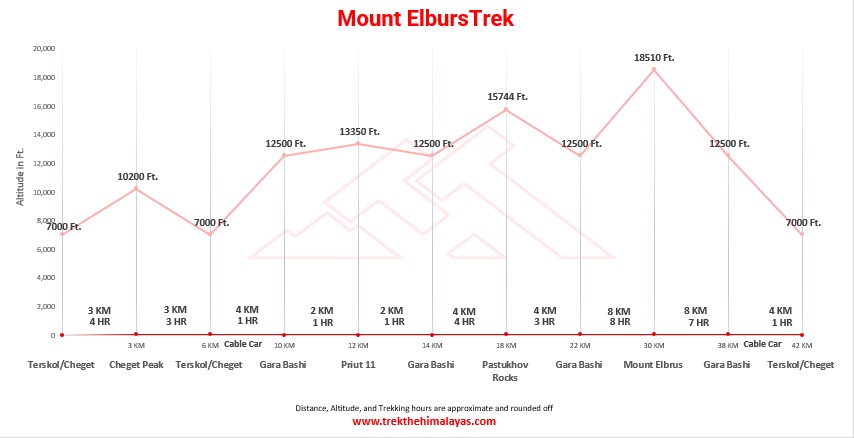
_11zon.webp)
- Pulse rate at rest must be in between (60 to 100 beats per minute).
- Blood Pressure Reading must be in between (DIASTOLIC 75 – 85, SYSTOLIC 100 - 130 mm Hg).
- Respiratory rate at rest must be in between (12 to 20 breaths per minute).
- Should not have Liver and kidney issues.
- Should not have Diabetes Mellitus, Bronchial Asthma, Heart problems, Hypertension, etc.
- No pacemaker implant.
- People with Sinus issues, Epilepsy please contact to trek coordinator before booking the trek.
- If your BMI is not normal, Please contact our Trek coordinator before Trek booking.
Medical & Disclaimer Form (Mandatory Documents) Click here to download Medical & Disclaimer Form
- Not updated.
- Not updated.
- Medical & Disclaimer Form (Mandatory Documents) Click here to download Medical & Disclaimer Form
The following preparations must be made before climbing Mt. Elbrus:
- You need to book your flights.
- You need to organize your visa.
- You need to get the required medical fitness certificate.
- You need to buy or rent the necessary equipment.
- You need to get yourself into shape.
Airports That Indian Visitors Can Enter
From India, you can fly to Tbilisi, Georgia (TBS) or Mineralnye Vody, Russia (MRV), both of which offer connections to Sochi, Russia (AER), the nearest airport to Mount Elbrus.
TTH will arrange pick-up from Mineralnye Vody, Russia (MRV) airport.
Currency: The Russian Ruble (RUB) is the official currency. You can exchange currency upon arrival or use ATMs that accept international cards.
Climate: Russia's climate varies greatly depending on the region. In the winter, temperatures can drop as low as -50°C (-58°F) in Siberia, while summers can be sweltering in the south. Moscow and St. Petersburg experience mild summers and cold winters.
Language: While Russian is the official language, many people, especially in the tourism industry, speak English. It's still a good idea to learn basic Russian phrases
Credit cards / Travellers Checks: When traveling to Russia, it's essential to be aware of the payment options available. Credit cards are widely accepted in major cities, particularly Visa and Mastercard, but less so in smaller towns and villages. Traveller's checks are not commonly used or accepted. Additionally, Russia has a cash-based economy, so having some local currency, Russian Rubles (RUB), is recommended.
Duty-free:When traveling to Russia from India, it's essential to know the duty-free allowances to avoid any customs issues. As an Indian citizen, you're entitled to duty-free items worth up to 1,500 rubles (approximately ₹19,000).
You can bring back goods like –
- Perfumes
- Cosmetics
- Toiletries
- Do not exceed 2 liters of wine, 1 liter of spirits, or 2 packets of cigarettes
- Additionally, you can bring back 250 grams of chewing tobacco or 50 cigars.
Always check with your airline for any specific restrictions on duty-free items, and declare all goods at customs to ensure a smooth journey.
Prohibited items:
When traveling from India to Russia, it's essential to know the prohibited items to avoid any issues. According to Russian customs regulations, the following items are strictly prohibited:
- Firearms
- Ammunition
- Explosives
- Toxic chemicals
- Certain types of medication
Additionally, certain plant and animal products, such as dried flowers, seeds, and live wood, may require special permits. Also, be aware that Russian customs may inspect electronic devices and media, so it's recommended to declare any valuable or sensitive items to avoid potential issues. Always check with the Russian Embassy or a reliable source for the latest information.
Insurance
It is strongly advised to take out travel insurance which should cover baggage as well as personal accident and medical insurance and specifically covering your Mt. Elbrus expedition.
FOOD ON TREK:
Healthy, satiating, and nutritious food will be served during the trek. However, if you are a vegetarian please inform the team before embarking on this trek. Please specify if you follow any diet restrictions so that the team can arrange accordingly.
Important Links
- Mandatory Documents to Bring on A Trek Click Here.
- How to pay Add-ons, Submit Medical Forms, and Dietary Preferences Click Here to watch Video
How To Reach
Pick-Up Information
Pick-up Location: Mineralnye Vody Airport (MRV), Russia.
Once you land in Mineralnye Vody, all further travel arrangements will be handled by the TTH team, as per the itinerary.
Pick-up Time: 11:00 AM at Mineralnye Vody Airport (MRV).
Options to Reach Mineralnye Vody
-
By Flight (Recommended)
International Travelers:
The nearest airport to Mount Elbrus is Mineralnye Vody Airport (MRV) in Russia. It is accessible via major international transit hubs such as Moscow or Saint Petersburg.
For Travelers from India:
There are no direct flights from India to Mineralnye Vody. However, it is easily reachable through connecting flights. The most commonly used routes include:
• India → Moscow → Mineralnye Vody
• India → Dubai → Mineralnye Vody
- Major Indian airports like Delhi, Mumbai, and Bengaluru have flights to Moscow or Dubai. From there, you can take a connecting flight to Mineralnye Vody.
-
Customs & Travel Time
The total travel duration from India to Mineralnye Vody is approximately 11-12 hours, depending on the chosen transit route.
Drop-Off Information
- The expedition ends at Mineralnye Vody Airport, and TTH will provide return transportation from the mountains to the airport.
- Drop-off Time: The designated drop-off point is Mineralnye Vody Airport (MRV), Russia at 1:00 PM
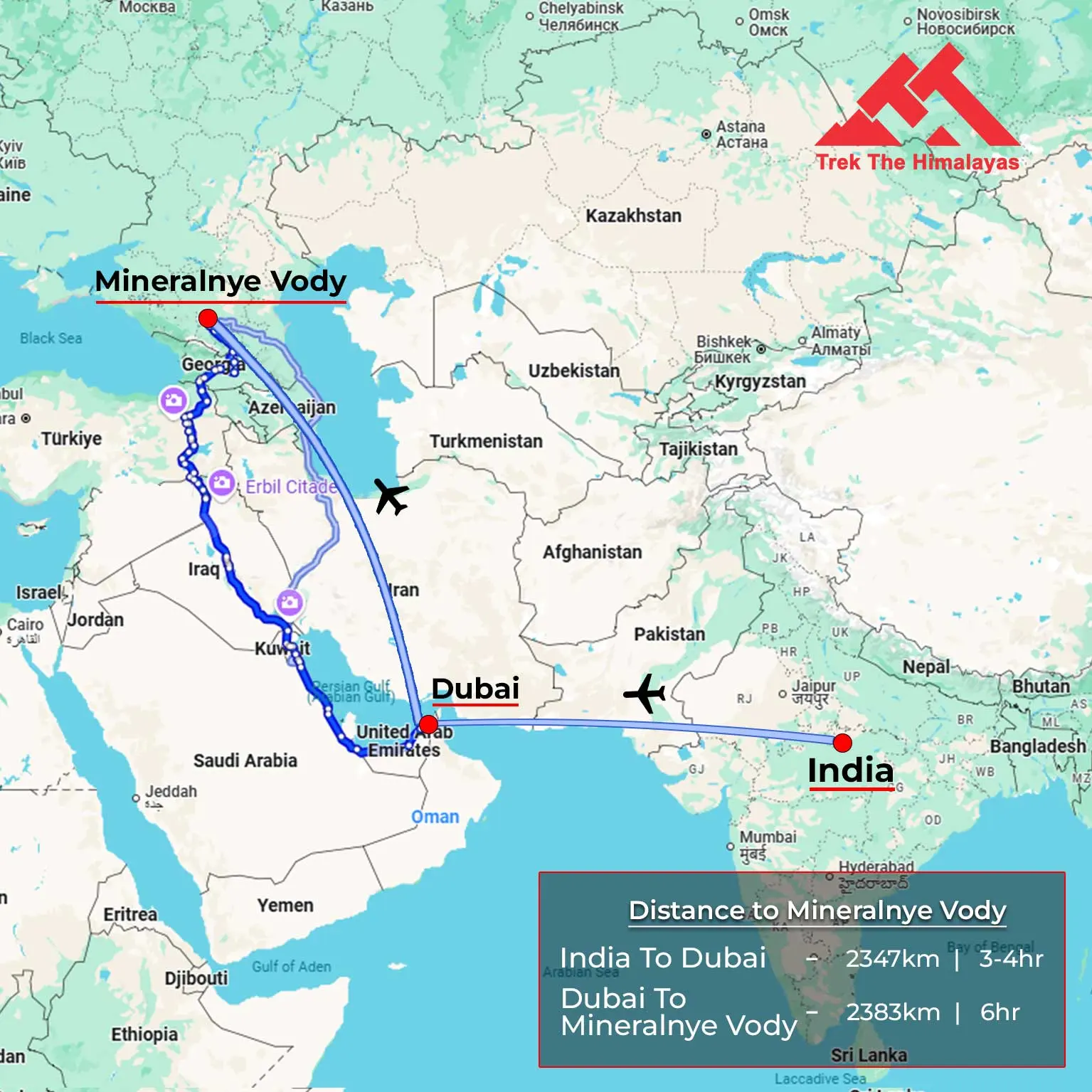
Cost Terms
Inclusion
1. Accommodation (As per the itinerary)
- Day 1, Day 2 and Day 7 night stay at the 3-star Hotel in Terskol/ Cheget Glade, Standard twin-sharing rooms.
- Day 3, Day 4, Day 5, Day 6 night stay in barrel huts at Gara-Bashi.
2. Meals (Vegetarian+Egg)
- All meals from Day 1 dinner to Day 8 breakfast
3. Professional Support Team
- A versatile base camp manager who ensures clear communication and swiftly deploys additional manpower during emergencies.
- 1 Mountaineering & First Aid Certified Expedition Leader
- 1 Experienced High-Altitude Chef
- Local Guides (Number based on group size)
- Sufficient Support Staff for logistics and safety
- Additional summit-day guides (1 guide per 3 climbers).
- One Trek Leader from India TTH Team
4. First Aid
- First aid kit
- Stretcher
- Oxygen cylinder
- Blood pressure monitor
- Oximeter
- Stethoscope
4. Load Support
- Porters to carry central/common luggage such as camping gear, food supplies, and equipment.
5. Permits & Entry Fees
- All required permits and entry fees included .
6. Trek Completion Certificate
- Certificate of Completion provided by Trek The Himalayas (TTH).
7. Luggage Facility
- You can safely leave your extra luggage at Base Camp during the trek.
8. Transportation
- Round-trip transfers between Mineralnye Vody Airport and the hotel.
9. Cable Cars
- Cable car rides to Gara Bashi and back as per the itinerary.
Exclusion
- Personal trekking/mountaineering gear. (Available for rent on request.)
- Snowcat Services (Optional)
- Ascent to 5100 meters: 15,000 rubles
- Descent from 5100 meters: 9,000 rubles
- Flight tickets to and from Mineralnye Vody. - Domestic & International
- Breakfast & Lunch on Arrival Day.
- Porter to carry personal luggage.
- Any kind of personal expenses.
- Personal Insurance.
- Visa security & Fees.
- Emergency evacuation, hospitalization charge, etc.
- Any extra costs incurred due to extension/change of the itinerary due to natural calamities, roadblocks, vehicle breakdown, etc. — factors beyond our control.
- Anything not specifically mentioned under the head Inclusion.
Cancellation Terms
To request a cancellation, please email us at info@trekthehimalayas.com using your registered email ID.
Cancellations prior to 25 days from the start of the Trip
Refund Options
- 5% deduction of trek fee
- 100% cash voucher for any trip till one year
- Transfer your trek (any trek, any date) to your friend
Cancellation between 24 days and 15 days to the start of the Trip
Refund Options
- 30% deduction of trek fee
- 100% cash voucher for same trip till one year
- 85% cash voucher for any trip till one year
- Transfer your trek (same trek, any date) to your friend
Cancellation between 14 days and 10 days to the start of the Trip
Refund Options
- 50% deduction of trek fee
- 80% cash voucher for same trip till one year
- 70% cash voucher for any trip till one year
- Book the same trek, in the same season, with any other batch
- Transfer your trek (same trek, any date) to your friend
Cancellation less than 9 days to the start of the trek.
Refund Options
- No cash refund
- 20% cash voucher for the same trip till one year
- 10% cash voucher for any trip till one year
- Transfer your trek (same trek, same date) to your friend
Cancellation Policy (Emergency Cases):
In case of a death in the immediate family (parents, siblings, spouse, children) or if the trekker is hospitalized (min. 48 hours) or suffers a fracture (leg/arm) within a week before the trek, even if canceled a day before:
90% refund in cash & 10% as a voucher (valid for 1 year, for any India trek)
Valid documents required. We’re here to support you during tough times.
Note:
- Change of trek batch is dependent on the availability of seats in the batch
- In case of transferring a trek to a friend, he/she should satisfy all the mandatory requirements put forward by TTH
- TTH holds the right to change/cancel the policies, without prior notice
Booking and Payments
- The Participant is responsible for verifying the accuracy of all details, including Trip dates and personal documentation, at the time of booking.
- Payments must be made in accordance with the timelines and instructions provided by TTH. Late payments may result in cancellation of booking without refund.
- In the event of a cash refund, only the portion of the payment made in cash shall be eligible for refund in cash. Any booking made using voucher, discounts, promotional codes, or through any non-cash mode of payment shall not be eligible for a cash refund under any circumstances.
- Refunds, if applicable, shall be processed within 15–30 working days of confirmation.
- Voucher Terms
- This is a non-transferable voucher
- The voucher cannot be merged with any other offer of Trek The Himalayas
- The voucher is valid for Trek booked directly with Trek The Himalayas in India
- To avail the voucher please use your register phone number or e-mail id
- All the other Terms of booking a trek with Trek The Himalayas are applicable to the voucher
Itinerary and Modifications
- TTH reserves the right to modify, shorten, or cancel any part of the Trip due to transportation delays, weather, health emergencies, or other unforeseen circumstances including Force Majeure.
Cancellations and Refunds
- No refunds or vouchers, partial or otherwise, shall be provided for voluntary withdrawal, non-utilisation of services, or removal from the Trip.
- If TTH cancels the Trip before arrival at the designated pick-up point due to unforeseen circumstances or Force Majeure, the Participant may choose from:
- An alternate Trip/date.
- A credit voucher valid for one (1) year.
- Transfer to another Trip, with cost differences payable by the Participant.
- If the Trip is abandoned post-arrival at the designated pick-up point, no cash refund or voucher shall be issued. The Trek Again Policy may apply at TTH’s discretion.
- TTH shall not be liable for any associated travel costs such as flights, accommodation, or visa fees.
Force Majeure
- Events beyond its control including but not limited to earthquakes, landslides, strikes, curfews, war, pandemic, government restrictions, heavy rainfall or snowfall, windstorms, road blockages, trail disruption, or withdrawal of permits, TTH shall not be held liable for any cancellation, delay, or service modification caused by Force Majeure.
Trek Essentials
Rent EquipmentPDF Of Trek Essential Download
| Backpack with rain cover | (50 - 60 ltr) with comfortable shoulder straps |
| Day pack with rain cover | 20 - 30 ltr (If off-load opted) |
| Walking stick | Advisable (At least one) |
| Water Bottle / Hydration pack | 2 bottles of one liter each, People who use hydration pack 1 hydration pack and 1 bottle of one liter, Carry at least one thermos flask. |
| Small size tiffin/lunch box | 1 Nos |
| Snacks | Energy bars, dry fruits, electral/ors |
| Personal Medical Kit | Consult your doctor |
| T-Shirt (Synthetic quick dry) | 1 Full & 2 Half sleeves |
| Fleece T-shirt | 1 Nos |
| Wind stopper / Fleece jacket | 1 Nos |
| Windproof Jacket | 1 Nos |
| Down feather / Hollow jacket | 1 Nos |
| Thermal inner (Upper and Lower) | 1 Pair |
| Trek Pant (Synthetic quick dry) | 2 Nos |
| Wind stopper / Fleece Pant | 1 Nos |
| Waterproof gloves | 1 Pair |
| Fleece / woollen gloves | 1 Pair |
| Poncho / waterproof Jacket and pant | 1 Nos |
| Sunscreen | 1 Nos |
| Moisturiser | 1 Nos |
| Chap-stick / Lip balm | 1 Nos |
| Toothbrush and toothpaste | 1 Nos |
| Toilet paper & Wipes | 1 Nos |
| Soap / hand sanitizers | 1 Nos |
| Antibacterial powder | 1 Nos |
| Quick dry towel | 1 Nos |
| Head torch | 1 Nos. (Avoid Hand torch) |
| Sun Cap | 1 Nos. |
| Woolen cap | 1 Nos. |
| Balaclava | 1 Nos. |
| Buff / Neck-gaiters | 1 Synthetic & 1 Woollen |
| Sunglasses | UV with dark side cover, People who wear spectacles - (A)- Use contact lenses | (B)- Photo chromatic glasses |
| Trekking shoes | 1 Pair (Waterproof, high ankle, good grip) |
| Floaters / flip-flops | 1 Pair |
| Cotton socks | 7 pairs |
| Woollen socks | 2 pairs |
| Gaiters | 1 Pair (TTH provides when required) |
| Micro spikes | 1 Pair (TTH provides when required) |
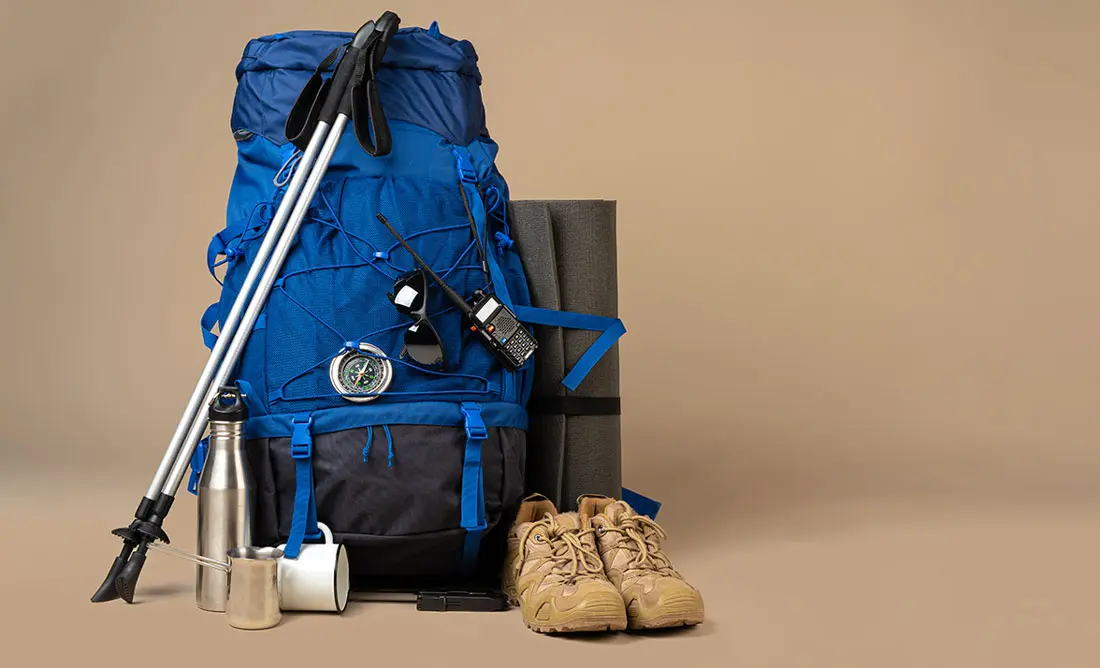
Frequently Asked Questions(FAQ)
To register with TTH, visit our website - www.trekthehimalayas.com and create your account. To create your account you will need to use your email address and fill in all the details, set your unique password and your account is ready to use.
- To book a trek with TTH, you first need to register with us and create an account.
- Choose the trek that you want to do and click on available dates.
- You will land at the login page, fill in the required details.
- Add Participants, choose add-on services click on the Pay now button, choose your preferred payment method, and make the payment. TTH accepts multiple payment options, including credit/debit cards, net banking, and UPI.
- You will receive a confirmation email from TTH with all the necessary details about the trek, including the meeting point, transportation, accommodation, and other important instructions.
- Click Here to watch Video
please send an email to us at info@trekthehimalayas.com or reach out to the numbers provided in the Help and Support section of your Trek Page. We will ensure that your issue is promptly resolved.
To book services such as off-load luggage and transportation, you can find them listed as add-ons. These additional services can be booked at the time of your initial booking. If you miss booking add-ons during the initial reservation, you can log in anytime and easily book 4 days before the departure date add-ons through the platform.
If you have booked the wrong trek or selected the wrong date, don’t worry! You can contact us at +91 9368882322 (Monday to Saturday, 10 AM to 10 PM) or email us at info@trekthehimalayas.com. You can also discuss this with your trek coordinator. Please make sure to inform us at least 10 days before the departure of your trek. Only then can we help you reschedule or arrange another trek for you.
We recommend visiting our "Suggest Me a Trek" page. By filling out the form, our experts will contact you with the best possible trek options based on your preferences and experience level. Alternatively, you can reach out to us via email at info@trekthehimalayas.com or give us a call using the numbers provided on our website for personalized assistance and recommendations.
Family treks differ from regular treks by focusing on ease of difficulty, offering shorter durations for younger participants, Kid-friendly and easily digestible foods, child-friendly activities, maintaining a higher guide ratio for diverse age groups, and implementing additional safety measures for families.
Family Trek with Kids recommendation Only Dayara Bugyal and Chopta Chandrashila Trek.
Minimum age for TTH treks is typically 7 years, though this may vary depending on the specific trek.
Yes, you can take a kids to a high-altitude trek with a parent. Discuss with a trek expert before booking a trek.
- Junior trekkers (below 15 years) should have a company of parents/guardians.
- Trekkers between 15 to 18 years can come solo with the disclaimer form signed by parent/guardian.
- Medical & Disclaimer Form (Mandatory Documents) Click here to download medical and disclaimer form
Physical Fitness: Ensure your child is physically fit. Engage them in regular exercise, outdoor activities, and hikes to build stamina and endurance. Hydration: Emphasize the importance of staying hydrated at high altitudes. Encourage your child to drink water regularly, even if they don't feel thirsty. Proper Nutrition: Provide a well-balanced diet with sufficient carbohydrates for energy and foods rich in iron to prevent altitude sickness. Adequate Sleep: Ensure your child gets enough sleep in the days leading up to the trek. Quality rest is crucial for altitude adaptation. Educate on Altitude Sickness: Teach your child about the symptoms of altitude sickness, such as headache, nausea, and dizziness. Encourage them to communicate any discomfort immediately. Appropriate Clothing and Gear: Dress your child in layers to adjust to changing temperatures. Ensure they have appropriate trekking gear, including sturdy footwear. Positive Mindset: Foster a positive mindset. Encourage your child, and let them know it's okay to take breaks when needed. Medical Check-Up: Schedule a medical check-up before the trek to ensure your child is fit for high-altitude activities. Consult with a healthcare professional about any potential health concerns.
TTH takes special care to provide wholesome and nutritious food for children on treks. Here are some of the foods that are typically served for children:
Breakfast: For breakfast, TTH serves a variety of options like porridge, cornflakes, bread, butter, jam, honey, boiled eggs, omelettes, and pancakes. Children can choose from these options to fuel themselves for the day's trek.
Lunch: For lunch, TTH serves lunch which includes rotis, vegetables, rice, dal, and salad. The rotis are usually made fresh on the trek and are a good source of carbohydrates. The dal and vegetables provide protein and other essential nutrients.
Snacks: TTH provides healthy snacks like fresh fruits, dry fruits, energy bars, cookies, and biscuits to keep the children energized throughout the day.
Dinner: For dinner, TTH serves a hot and wholesome meal which includes soup, rice, dal, vegetables, and a non-vegetarian dish (if requested in advance). Children can also choose from a variety of desserts like custard, jelly, and fruit salad.
Dietary requirements: If a child has any special dietary requirements, TTH can cater to those needs as well. For example, if a child is lactose intolerant or allergic to nuts, the kitchen staff can make arrangements to accommodate those requirements.
Choosing the right trek for a beginner can be a bit overwhelming as there are many factors to consider such as distance, elevation gain, terrain difficulty, weather, and time of year. Here are some tips that can help you choose the right trek for a beginner:
1. Determine fitness level: Assess the fitness level of the beginner to understand their physical capabilities. This will help you select a trek that is challenging but not too difficult.
2. Choose a well-traveled trail: A well-traveled trail will have more amenities such as signposts, water stations, and shelter. It is also safer as there will be other hikers on the trail.
3. Consider the length of the trek: For beginners, it is recommended to start with a shorter trek that can be completed in a day or two. This will help them get acclimatized to trekking and build their confidence.
4. Look for gradual elevation gain: Choose a trek with a gradual elevation gain rather than steep ascents. This will make the trek easier and more enjoyable.
5. Check the weather: Check the weather forecast before selecting a trek. Avoid treks during the monsoon season or winter when the trails can be slippery or dangerous.
6. Research the trail: Read about the trail to get an idea of the terrain, altitude, and difficulty level. This will help you select a trek that is suitable for the beginner.
7. Consult with an expert: If you are unsure about which trek to choose, consult our trek expert Mr. Nitin (+91 70600 59773) between 10 AM to 6 PM (Tuesday - Friday). Mr. Nitin will provide you valuable advice and guidance.
Overall, it is important to choose a trek that is enjoyable, challenging but not too difficult, and suitable for the beginner's fitness level and experience.
It is not recommended for a beginner to choose a difficult Himalayan trek. Trekking in the Himalayas can be physically and mentally challenging, especially if you are not used to the high altitude, steep slopes, and rugged terrain. Choosing a difficult trek without the proper experience, fitness level, and preparation can be dangerous and put you at risk of altitude sickness, injury, and other hazards.
If you are a beginner, it is recommended to start with an easier trek and gradually build up your skills and experience. This will help you understand the challenges of trekking in the Himalayas, and also prepare you physically and mentally for a more difficult trek in the future. It is also important to choose a trek that matches your fitness level, experience, and interest.
There is no specific age limit for a beginner trekker. However, it is important to consider your physical fitness, health condition, and personal interests before embarking on a trek. Trekking in the Himalayas can be physically and mentally demanding, and requires a certain level of physical fitness and endurance.
If you have any pre-existing medical conditions or are above a certain age, it is recommended to consult with a doctor before embarking on a trek. It is also important to listen to your body and take breaks as needed during the trek to prevent exhaustion or injury.
We recommend visiting our "Suggest Me a Trek" page. By filling out the form, our experts will contact you with the best possible trek options based on your preferences and experience level. Alternatively, you can reach out to us via email at info@trekthehimalayas.com or give us a call using the numbers provided on our website for personalized assistance and recommendations.
Yes, you can join the trek. We have fixed departure groups where you can simply book your trek and we will take care of curating a group.
Before you start the trek, it is recommended that you make all the necessary phone calls as during the trek you may or may not receive network coverage, once you come back to the Base Camp, you can reconnect with your family via phone once again. You can share your trek coordinator contact detail with your family members to get the latest updates about your trek batch.
At TTH, we provide wholesome and nutritious meals during the trek. The food is vegetarian and includes a variety of dishes such as rice, dal, vegetables, chapati, paratha, pasta, noodles, and soup. We also offer snacks such as biscuits, and salty, and dry fruits during the trek. Special dietary requirements such as vegan, gluten-free, or Jain food can also be arranged if informed in advance.
If you are allergic to some foods, you need to let us know in advance so that we can make arrangements accordingly.
TTH is a trekking company that prioritizes the safety of all its participants, including women trekkers. We have a comprehensive safety system in place, which includes a dedicated team of experienced and trained trek leaders and support staff who are equipped to handle emergency situations and provide first aid.
TTH also takes specific measures to ensure the safety and comfort of women trekkers. They have a separate tent accommodation for women trekkers, female trek leaders, and support staff. They also provide separate toilet facilities for women and encourage a safe and respectful environment for all trekkers.
Moreover, TTH has a strict policy against any kind of harassment and has a zero-tolerance policy towards such incidents. They have a designated Internal Complaints Committee (ICC) to investigate and address any complaints related to harassment or misconduct. Overall, TTH has a good reputation for safety and responsible trekking practices, and women can feel comfortable and safe while trekking with them.
In case you are the only women in the group, we provide a single sleeping arrangement. Also, during the trek, the trek leader will always remain by your side to provide optimum safety and reassurance.
You can reach out to the trek coordinator to inquire about the number of female trekkers and their respective states who have booked the trek. Please note that the trek coordinator cannot disclose personal details of any trekker. Once you've confirmed your booking, a WhatsApp Group will be created for all the trekkers in your batch. This allows you to connect with fellow trekkers before the trek begins.
While many of our treks are led by female trek leaders, however, it is not possible to know which trek leader is assigned to which group. But nonetheless, whether the trek leader is male or female you can be completely assured of your safety and security with us.
Yes, it is possible to trek with periods. However, it is important to take some extra precautions and preparations to ensure a comfortable and safe trekking experience. Here are some tips that can help you trek during your period:
1. Use menstrual hygiene products that you are comfortable with, such as tampons, pads, or menstrual cups. It is recommended to carry enough supplies for the entire duration of the trek.
2. Pack wet wipes, hand sanitizer, and plastic bags to dispose of used hygiene products.
3. Wear comfortable and breathable clothing that allows for easy movement and reduces friction. Avoid wearing tight or restrictive clothing that can cause discomfort.
4. Carry pain relief medication, such as ibuprofen or acetaminophen, in case of menstrual cramps.
5. Stay hydrated and maintain a balanced diet to support your energy levels and overall health.
6. Take breaks as needed and listen to your body. If you feel uncomfortable or experience any unusual symptoms, seek medical attention immediately. It is also recommended to consult with a doctor before going on a trek during your period, especially if you have a pre-existing medical condition or are taking medication.
By taking necessary precautions and being prepared, you can have a safe and comfortable trekking experience even during your period. We provide proper disposal facilities for sanitary pad disposal during the trek.
We offer three person tents with twin-sharing for optimum comfort. A woman trekker will share a tent with another woman trekker and if you are the only woman in the group, you will be given a single accommodation for your comfort and privacy.
Yes, we do provide gears on rent. You can book it using you TTH account directly.
Mountaineering qualified Experienced and first aid certified Trek Leader, First Aid Certify local guide, Cook, helpers and supporting staff.
People suffering from Bronchitis, Asthma, High blood pressure, Epilepsy (got faints), TB , Heart problem or on higher BMI side are strictly not allowed to go on any Himalayan trek. Apart from this if you had any medical history, please let us know.
No. Alcohol and smoking isn’t allowed while on trek. It is totally misconception that it will keep you warm. Your body need to acclimatize properly and for that eat properly and drink enough water; these things will keep you warm.
Toilet tents provide a convenient solution for answering nature's call in the great outdoors. Dry toilets, in particular, offer a highly sanitary approach. By digging a pit and utilizing mud and a shovel, you can easily cover up your waste. This method ensures cleanliness and hygiene while camping or exploring in the forest.
Remember to pack essential toiletries to complete your outdoor bathroom kit and maintain proper personal hygiene during your adventures. With these practices in place, you can enjoy nature while also respecting it.
Layer Up From Head To Toe
Eat Full Meals, never sleep empty stomach
You can keep warmee (if you’re more susceptible to cold).
Use sleeping bag in right way and don’t leave free space in sleeping bag.
For upper body
– Thermal layer
– T-shirt (full-sleeves)
– Fleece T-shirt (for extreme colds)
– Fleece layer
– Thick Jacket/Down Jacket
– Waterproof or Windproof layer (outermost layer, when it is snowing or raining)
- For Lower Body
– Thermal layer
– Hiking pants (normal) or Winter hiking pants
Based on how warm you feel you can skip any of the above layers. Your outer later should be windproof since it is windy at high altitude.
The idea behind layering is that the more insulation you have the less cold you feel, and instead of wearing a very thick jacket if you wear multiple layers, your body will be better insulated against the cold.
Yes, we provide micro spikes and gaiters, if required.
Mandatory documents: 2 xerox of ID having address (addhar card/driving license), 2 Passport size photographs, hard copy Medical form signed & sealed by doctor, disclaimer form sign by trekker and high altitude insurance.
No. We don’t but we can suggest you good hotel/Stay nearby pick up location.
Yes, trekker must carry 2 water bottles 1 litre each so they can refill it at campsite for drinking and keep themselves hydrate.
You should buy shoes which has these three features –Good grip, Ankle Support and additional water resistant layers. Generally, we advise Quechua Trek 100, MH 500 and MH 100.
No one is forced to go on. There is always enough staff to split the party according to need and regroup later at the camp. Most people have no trouble reaching the highest campsite. If some members decide not to climb the final distance they can wait for the climbers to come back down the same way or take a lateral path to the descent route.
Mount Elbrus is situated in the western Caucasus Mountains in southern Russia, near the border with Georgia. It is part of the European continent and is recognized as the highest peak in Europe, standing tall at 5,642 meters (18,510 feet) above sea level. Because of this, it’s also one of the Seven Summits.
Mount Elbrus stands at 5,642 meters (18,510 feet), making it the highest peak in Europe and one of the Seven Summits.
Yes, Elbrus is a dormant volcano. It has not erupted in recorded history, but its twin peaks are remnants of its volcanic past.
Elbrus is considered a non-technical climb but still challenging due to the altitude, glacier terrain, and weather conditions. Climbers need good physical fitness and some experience with snow gear like crampons.
You don’t need to be a technical climber to summit Elbrus, but you should have some experience with high-altitude trekking or snow hiking. Many trekkers choose Elbrus as their first big expedition, especially if they’re preparing for tougher peaks. Training beforehand, especially for cardiovascular fitness and stamina is essential.
The best time to climb Mount Elbrus Expedition is from July to September, which is the main climbing season. During these months, the weather is relatively stable, the snow is firmer, and the cable cars and barrel huts remain open and accessible. Outside this window, climbing becomes more technical due to heavier snowfall, colder temperatures, and reduced visibility.
Most Elbrus Expeditions take around 8 days, including acclimatization hikes, rest days, and a buffer day in case of bad weather. The itinerary usually includes a few days at lower altitude, a stay in the barrel huts at Gara-Bashi base camp, and summit day, which starts late at night.
In the lower areas like Terskol or Cheget, you’ll stay in cozy hotels. At high altitudes (Gara-Bashi base), you stay in barrel huts, which are cylindrical shelters that provide insulated sleeping arrangements. These huts are iconic to the Elbrus experience.
Essential gear includes crampons, ice axe, mountaineering boots, gaiters, down jacket, layered clothing, and a helmet. Most of the technical equipment is available for rent locally.
Yes. Elbrus is snow-covered year-round. Even in summer, temperatures can drop to –20°C to –30°C, especially on summit day.
The nearest airport to Mount Elbrus is Mineralnye Vody Airport (MRV) in Russia. From there, it’s approximately a 4 to 5-hour drive to the base villages of Terskol or Cheget, where the expedition begins. Trek The Himalayas (TTH) arranges all local transfers from the airport to the base village as part of the expedition package, ensuring a smooth and hassle-free arrival for all participants.
Many climbers opt to use a snowcat. It is a tracked vehicle designed to move over snow to ascend from base camp up to Pastukhov Rocks (4,600–4,800 m). This helps conserve energy, time and makes summit success more achievable. The final push to the summit still requires a long and demanding climb. The snowcat is optional but widely used.
Yes. Most international travelers need a Russian visa, and your trek operator usually provides visa support documents.
With proper preparation, trained guides, and acclimatization, Elbrus is a relatively safe expedition. However, like all high-altitude mountains, it carries risks: altitude sickness, extreme weather, whiteouts, and crevasses. That’s why reputable guides, weather buffers, and first aid measures are critical.
Absolutely. Elbrus represents Europe in the Seven Summits, a mountaineering milestone that includes climbing the tallest mountain on each continent. For many climbers, Elbrus is the first or second peak attempted due to its non-technical route and relatively accessible logistics compared to other summits.
The cost to climb Mount Elbrus varies depending on the services included. A full expedition package with a reliable operator, including airport transfers, accommodation, meals, guides, permits, and cable cars, generally costs ₹1.6 lakhs INR. Snowcat rides, personal gear rental, visa fees, and international flights are typically not included and are charged separately.
Both mountains present challenges, but in different ways. Elbrus is colder, higher (5,642 m vs. 5,895 m for Kilimanjaro), and has more unpredictable weather. The summit day on Elbrus involves walking over snow and possibly using crampons, which makes it technically more demanding, though shorter in duration. Kilimanjaro is physically tough but requires no mountaineering skills. So in terms of weather, terrain, and preparation, Elbrus is considered harder.
While Mount Elbrus is classified as a non-technical peak, it is not typically suited for complete beginners. Prior experience with high-altitude trekking is recommended, along with a good level of physical fitness. Some basic mountaineering skills like walking with crampons and using an ice axe may be taught on the expedition, but a beginner must be willing to train and prepare well in advance.
Thousands of climbers from around the world have successfully summited Mount Elbrus. Being one of the Seven Summits, it is a major milestone for many mountaineers. Each year, many people attempt the climb, and with proper acclimatization and guidance, reaching the summit is achievable for well-prepared climbers.
Elbrus is not a technical climb, but it is challenging due to the altitude, cold weather, and long summit day. The climb requires excellent physical fitness, mental endurance, and readiness to face harsh mountain conditions. With experienced guides and acclimatization, it is an achievable climb for well-prepared trekkers.
Yes, climbing Elbrus is generally safe when done with a licensed operator and proper acclimatization schedule. The route has infrastructure, guides, snowcats, and established safety systems. Risks like altitude sickness and bad weather exist, but with a good team and preparation, these can be managed effectively.
With Trek The Himalayas (TTH), all expeditions are led by certified guides, supported by a trained team, and structured to prioritize safety through well-planned acclimatization, medical support, and emergency response systems.
The route to climb Mount Elbrus involves:
Flying into Mineralnye Vody
Driving to Terskol or Cheget
Using cable cars to reach Gara-Bashi (3,800 m)
Acclimatizing with hikes to Priut 11 and Pastukhov Rocks
Summit push from Gara-Bashi.
The entire expedition takes around 8 days. You’ll need a guide, proper gear, and physical training.
Mount Elbrus is famous for being the highest mountain in Europe, making it one of the Seven Summits. Its beautiful setting in the Caucasus Mountains, along with the fact that it is accessible for fit non-technical climbers, makes it a popular destination for international adventurers.
Supplemental oxygen is not typically required for Mount Elbrus climbs, as the altitude (5,642 m) is manageable for most climbers with proper acclimatization. However, oxygen may be carried by guides for emergencies or in case someone has difficulty at higher altitudes.
Technically, yes, but it is strongly discouraged. The weather on Elbrus can change rapidly, and whiteouts are common. Climbing solo increases the risk. It's always safer and more practical to climb with an experienced guide or a certified group.
The best time to climb Elbrus is from July to September. These months have the most stable weather, with clearer skies, longer daylight, and firmer snow conditions. Outside of this window, the mountain becomes more technical due to snow buildup and extremely cold temperatures.
Day 1: Arrival at Mineralnye Vody – Drive to Terskol/ Cheget (Hotel Stay)
Day 2: Acclimatization hike to Mount Cheget
Day 3: Ascent to Gara-Bashi
Day 4: Acclimatization hike to Pastukhov Rocks
Day 5: Rest Day and Summit Preparation
Day 6: Summit Day- Ascent to Mt Elbrus and return to Gara-Bashi
Day 7: Reserve Day and Descent to Terskol/ Cheget
Day 8: Transfer to Airport
A full expedition package from India costs ₹1.6 lakhs INR, depending on the services offered. This typically includes airport transfers, hotel stays, mountain accommodation, meals, permits, guides, and cable cars. Additional costs include flights to Russia, visa fees, gear rental, and optional snowcat rides.
Mount Elbrus stands at 5,642 meters (18,510 feet) above sea level, making it the highest peak in Europe.
The summit of Mount Elbrus offers 360-degree panoramic views of the Caucasus Mountains. The western summit (5,642 m) is higher than the eastern summit (5,621 m) and is the true summit. Reaching it is a major accomplishment for trekkers and climbers alike.
